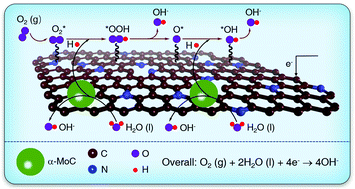Promoted oxygen reduction kinetics on nitrogen-doped hierarchically porous carbon by engineering proton-feeding centers†
Abstract
Electrocatalytic oxygen reduction reaction (ORR) is the vital process for next-generation electrochemical energy storage and conversion technologies, e.g., metal–air batteries and fuel cells. During the ORR, the O2* and O* intermediates principally combine with protons to form OOH* and OH* species, respectively, which are the proton-coupled electron transfer processes. Unfortunately, under alkaline conditions, the protons are essentially generated from the sluggish water dissociation process, which unavoidably limits the ORR kinetics. Herein, we design and synthesize a nitrogen-doped hierarchically porous carbon with homogeneously distributed ultrafine α-MoC nanoparticles (α-MoC/NHPC) as a model electrocatalyst. Theoretical investigations unveil that α-MoC on NHPC could efficiently reduce the energy barrier of the water dissociation process to generate protons, eventually promoting the proton-coupled ORR kinetics. In a 0.1 M KOH aqueous solution, α-MoC/NHPC exhibits excellent ORR performance with a high half-wave potential of 0.88 V (VS. reversible hydrogen electrode), which outperforms those for NHPC and commercial Pt/C. Moreover, as the air electrode in a zinc-air battery, α-MoC/NHPC presents a large peak power density of 200.3 mW cm−2 and long-term stability. Thereby, our approach to engineering proton-feeding centers paves a new avenue towards the understanding of ORR kinetics and the development of high-performance ORR electrocatalysts.



 Please wait while we load your content...
Please wait while we load your content...